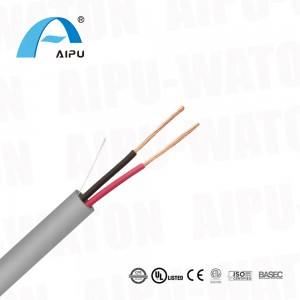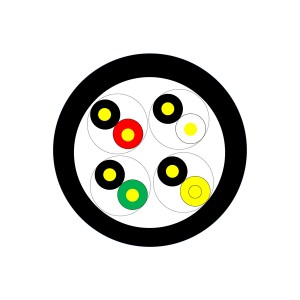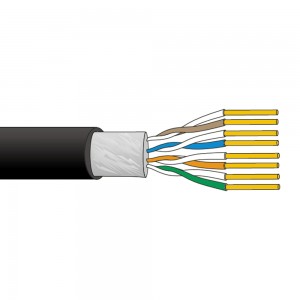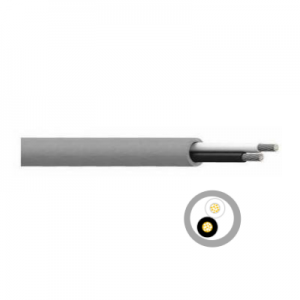Cable equivalente a Belden, cable de audio, cable de control de instrumentación, multipar sin blindaje con hilo de drenaje de cobre estañado
Solicitud
1. El cable está diseñado para aplicaciones de MS, sonido, audio, seguridad, control e instrumentación en interiores y exteriores. Disponemos de cables multipar. Se utiliza ampliamente en el control de procesos de producción y en la conversión de dispositivos de instrumentos de audio.
2. La cinta de Al-PET protegida individualmente con cable de drenaje de cobre estañado es opcional.
3. Están disponibles tanto cubiertas de PVC como de LSZH.
4. Los cables de control controlan señales en aplicaciones de control de automatización e instrumentación. Permiten medir y regular sistemas de automatización, transporte, construcción, minería e industria.
5. Los cables de control se dividen en CY (cable blindado), YY (cable sin blindar) y SY (cable de acero blindado). Los más comunes son los blindados con lámina de aluminio, los blindados trenzados o ambos. Los cables flexibles multipolares o multipar trenzado se seleccionan generalmente según los requisitos del cableado de campo o las ocasiones de uso. El calibre del cable de control es de 28 AWG a 2 AWG. Voltaje: 300 V, 450 V, 600 V a 750 V. Los cables de control no se utilizan para la transmisión de energía y suelen estar aislados con PVC convencional, ya sea blindado o sin blindaje.
6. La diferencia con los cables de alimentación radica en que estos últimos se utilizan para transportar electricidad, generalmente a 600/1000 V o superior, y suelen requerir una cubierta robusta. Tanto los cables de control como los de alimentación pueden utilizarse en aplicaciones industriales, residenciales y comerciales.
Construcciones
1. Conductor: alambre de cobre estañado trenzado
2. Aislamiento: Poliolefina, PVC
3. Cableado: Tendido de pares trenzados
4. Vaina: PVC/LSZH
Temperatura de instalación: superior a 0 ℃
Temperatura de funcionamiento: -15℃ ~ 70℃
Normas de referencia
BS EN 60228
BS EN 50290
Directivas RoHS
IEC60332-1
Identificación del aislamiento
| Voltaje de operación | 150 V, 300 V, 600 V |
| Voltaje de prueba | 1,0 kVcc |
| Conductor DCR | 57,0 Ω/km (máx. a 20 °C) para 22 AWG |
| 39,50 Ω/km (máx. a 20 °C) para 20 AWG | |
| 25,0 Ω/km (máx. a 20 °C) para 18 AWG | |
| 14,0 Ω/km (máx. a 20 °C) para 16 AWG | |
| 9,3 Ω/km (máx. a 20 °C) para 14 AWG | |
| Resistencia de aislamiento | 200 MΩhms/km (mín.) |
| N.º de pieza | Construcción de conductores | Aislamiento | Vaina | |
| Material | Tamaño | |||
| AP8205 | TC | 1x2x20 AWG | CLORURO DE POLIVINILO | CLORURO DE POLIVINILO |
| AP8205NH | TC | 1x2x20 AWG | S-PE | LSZH |
| AP9750 | TC | 3x2x20 AWG | CLORURO DE POLIVINILO | CLORURO DE POLIVINILO |
| AP9751 | TC | 6x2x20 AWG | CLORURO DE POLIVINILO | CLORURO DE POLIVINILO |
| AP9752 | TC | 9x2x20 AWG | CLORURO DE POLIVINILO | CLORURO DE POLIVINILO |
| AP9755 | TC | 15 x 2 x 20 AWG | CLORURO DE POLIVINILO | CLORURO DE POLIVINILO |
| AP8486 | BC | 1x2x19 AWG | CLORURO DE POLIVINILO | CLORURO DE POLIVINILO |
| AP8461 | TC | 1x2x18 AWG | CLORURO DE POLIVINILO | CLORURO DE POLIVINILO |
| AP8461NH | TC | 1x2x18 AWG | S-PE | LSZH |
| AP9740 | TC | 1x2x18 AWG | CLORURO DE POLIVINILO | CLORURO DE POLIVINILO |
| AP9740NH | TC | 1x2x18 AWG | S-PE | LSZH |
| AP9156 | TC | 2x2x18 AWG | CLORURO DE POLIVINILO | CLORURO DE POLIVINILO |
| AP9156NH | TC | 2x2x18 AWG | S-PE | LSZH |
| AP8690 | TC | 3x2x18 AWG | CLORURO DE POLIVINILO | CLORURO DE POLIVINILO |
| AP9157 | TC | 4 x 2 x 18 AWG | CLORURO DE POLIVINILO | CLORURO DE POLIVINILO |
| AP9159 | TC | 5 x 2 x 18 AWG | CLORURO DE POLIVINILO | CLORURO DE POLIVINILO |
| AP8691 | TC | 6x2x18 AWG | CLORURO DE POLIVINILO | CLORURO DE POLIVINILO |
| AP9161 | TC | 8x2x18 AWG | CLORURO DE POLIVINILO | CLORURO DE POLIVINILO |
| AP8692 | TC | 9 x 2 x 18 AWG | CLORURO DE POLIVINILO | CLORURO DE POLIVINILO |
| AP9741 | TC | 12 x 2 x 18 AWG | CLORURO DE POLIVINILO | CLORURO DE POLIVINILO |
| AP9742 | TC | 15 x 2 x 18 AWG | CLORURO DE POLIVINILO | CLORURO DE POLIVINILO |
| AP8471 | TC | 1x2x16 AWG | CLORURO DE POLIVINILO | CLORURO DE POLIVINILO |
| AP8471NH | TC | 1x2x16 AWG | S-PP | LSZH |
| AP8473 | TC | 1x2x14 AWG | CLORURO DE POLIVINILO | CLORURO DE POLIVINILO |
| AP8477 | TC | 1x2x12 AWG | CLORURO DE POLIVINILO | CLORURO DE POLIVINILO |
| AP9562 | TC | 2x2x24 AWG | CLORURO DE POLIVINILO | CLORURO DE POLIVINILO |
| AP9566 | TC | 6x2x24 AWG | CLORURO DE POLIVINILO | CLORURO DE POLIVINILO |
| AP9570 | TC | 10 x 2 x 24 AWG | CLORURO DE POLIVINILO | CLORURO DE POLIVINILO |
| AP8740 | TC | 1x2x22 AWG | CLORURO DE POLIVINILO | CLORURO DE POLIVINILO |
| AP8741 | TC | 2x2x22 AWG | CLORURO DE POLIVINILO | CLORURO DE POLIVINILO |
| AP8742 | TC | 3x2x22 AWG | CLORURO DE POLIVINILO | CLORURO DE POLIVINILO |
| AP8757 | TC | 4x2x22 AWG | CLORURO DE POLIVINILO | CLORURO DE POLIVINILO |
| AP8743 | TC | 6x2x22 AWG | CLORURO DE POLIVINILO | CLORURO DE POLIVINILO |
| AP9160 | TC | 8x2x22 AWG | CLORURO DE POLIVINILO | CLORURO DE POLIVINILO |
| AP8744 | TC | 9x2x22 AWG | CLORURO DE POLIVINILO | CLORURO DE POLIVINILO |
| AP9744 | TC | 2x2x22 AWG | CLORURO DE POLIVINILO | CLORURO DE POLIVINILO |
| AP9745 | TC | 3x2x22 AWG | CLORURO DE POLIVINILO | CLORURO DE POLIVINILO |
| AP9746 | TC | 4x2x22 AWG | CLORURO DE POLIVINILO | CLORURO DE POLIVINILO |
| AP8747 | TC | 6x2x22 AWG | CLORURO DE POLIVINILO | CLORURO DE POLIVINILO |
| AP8748 | TC | 9x2x22 AWG | CLORURO DE POLIVINILO | CLORURO DE POLIVINILO |
| AP9747 | TC | 12 x 2 x 22 AWG | CLORURO DE POLIVINILO | CLORURO DE POLIVINILO |
| AP8749 | TC | 15 x 2 x 22 AWG | CLORURO DE POLIVINILO | CLORURO DE POLIVINILO |
(Notas: Otros núcleos están disponibles a pedido).










